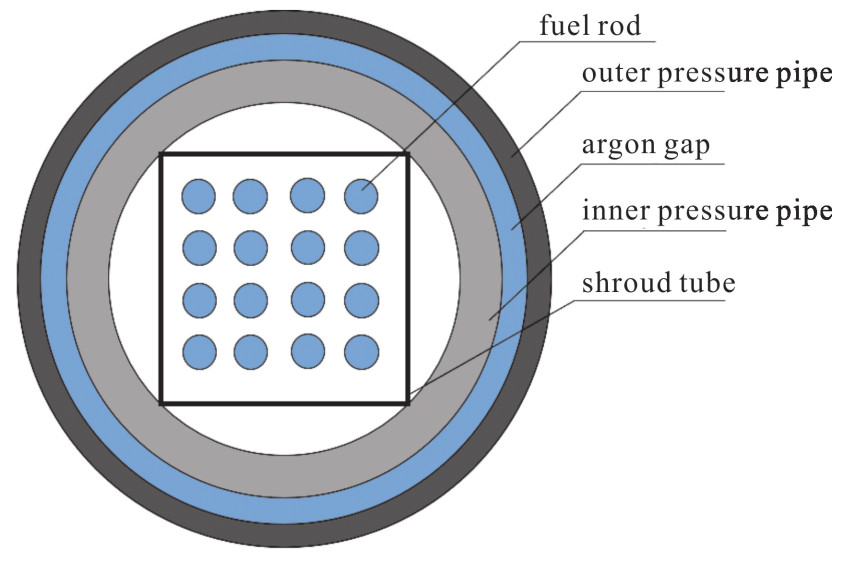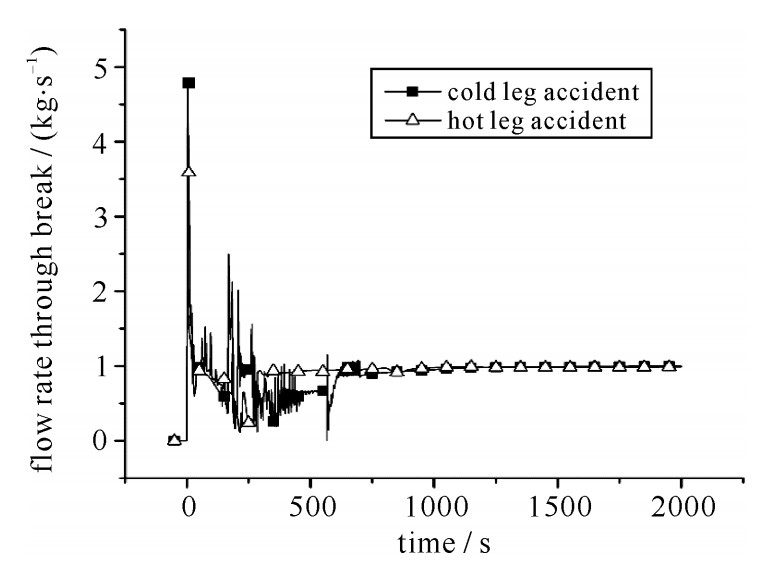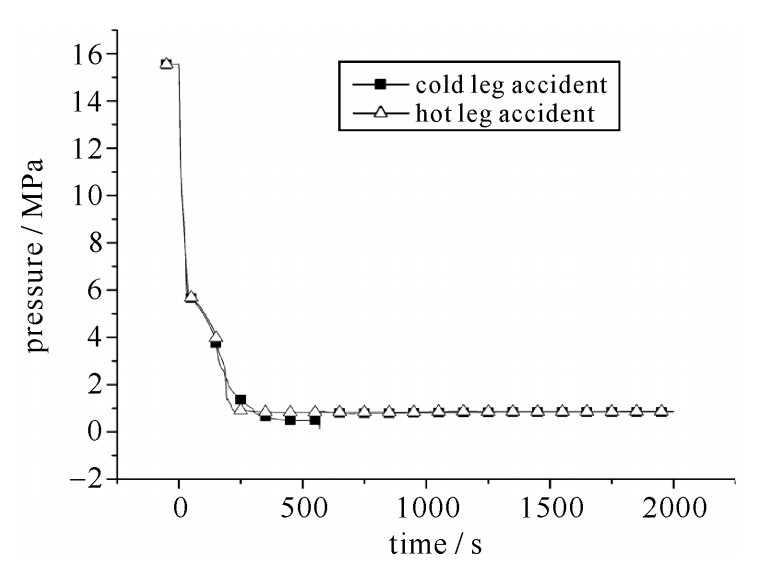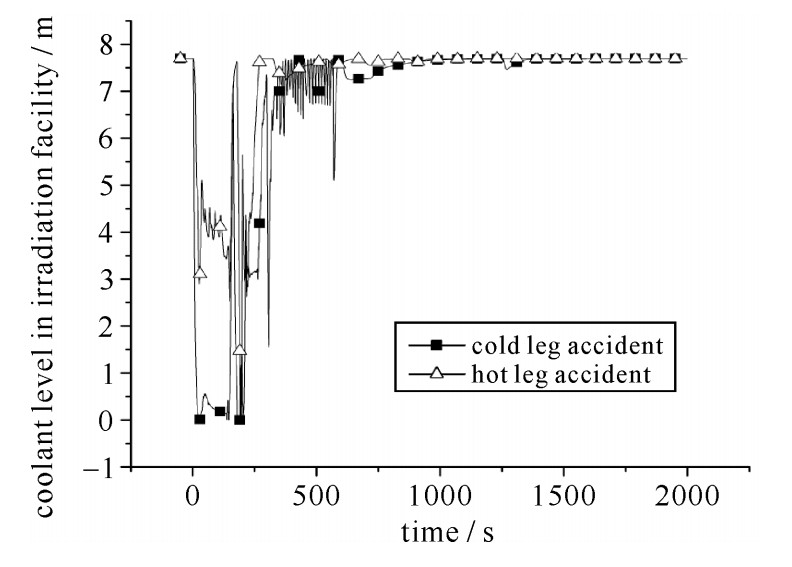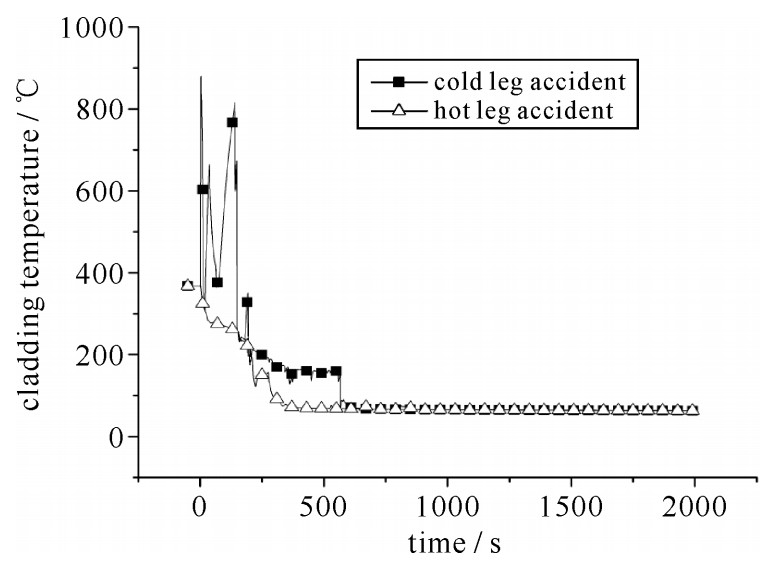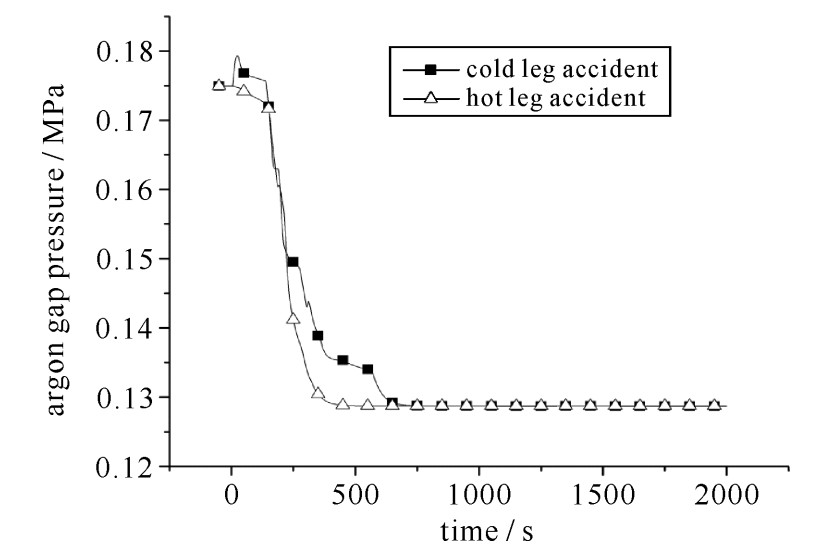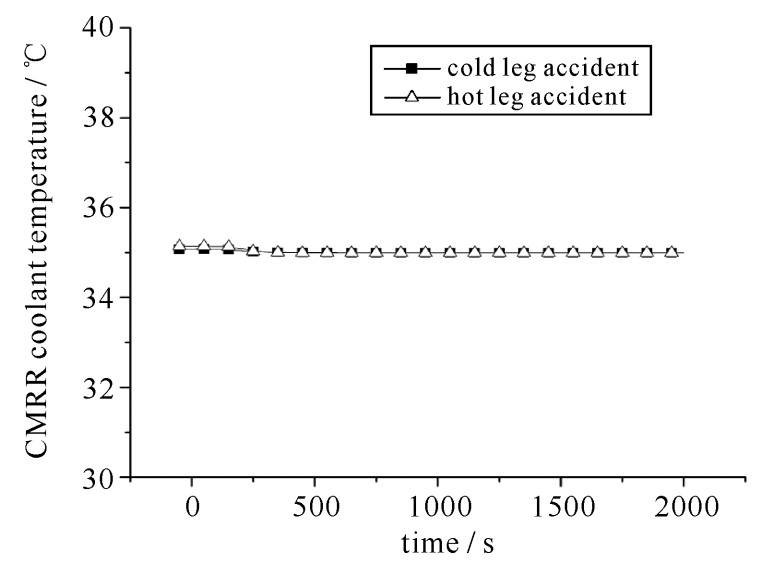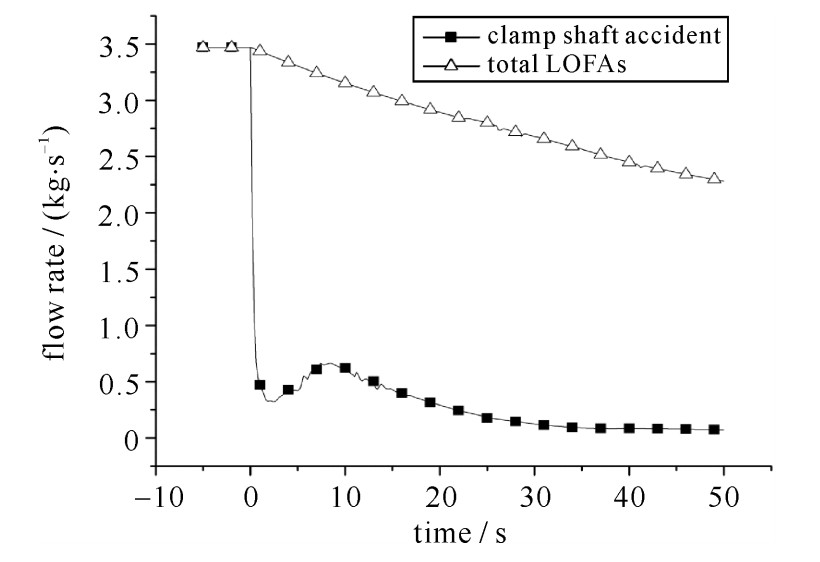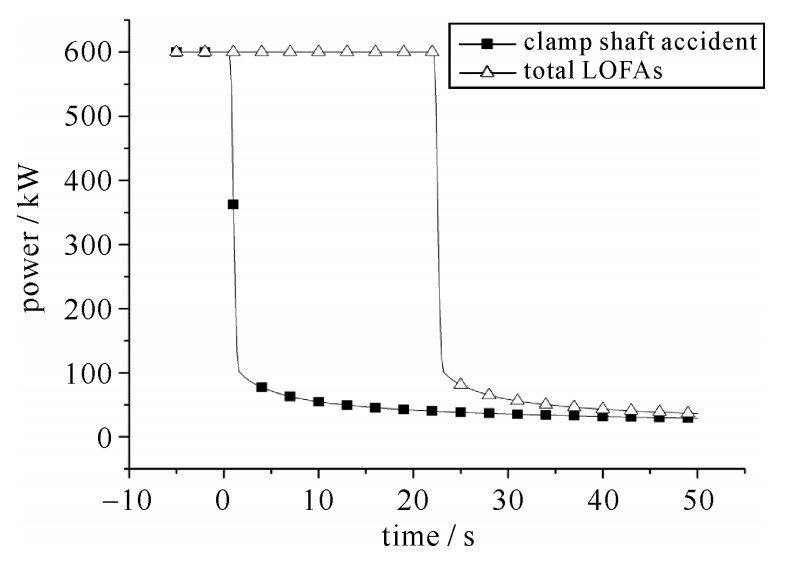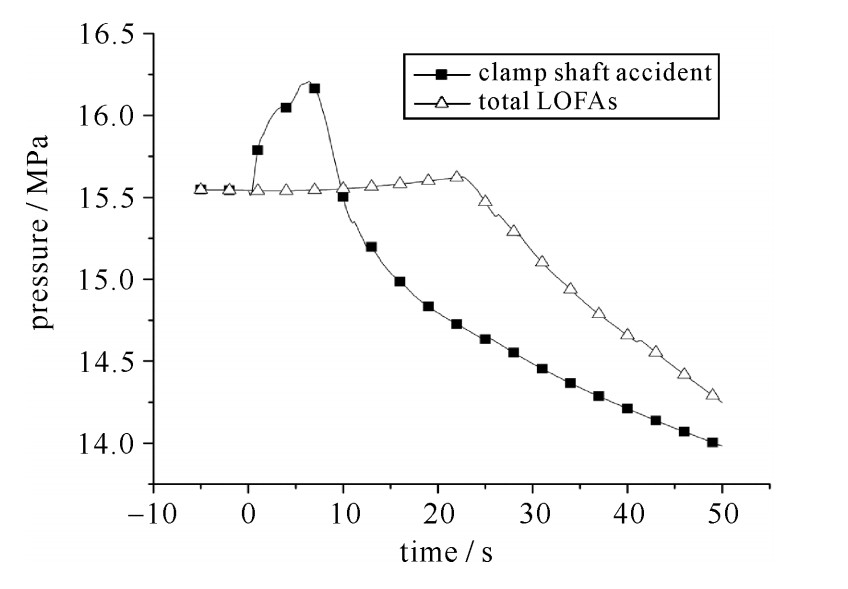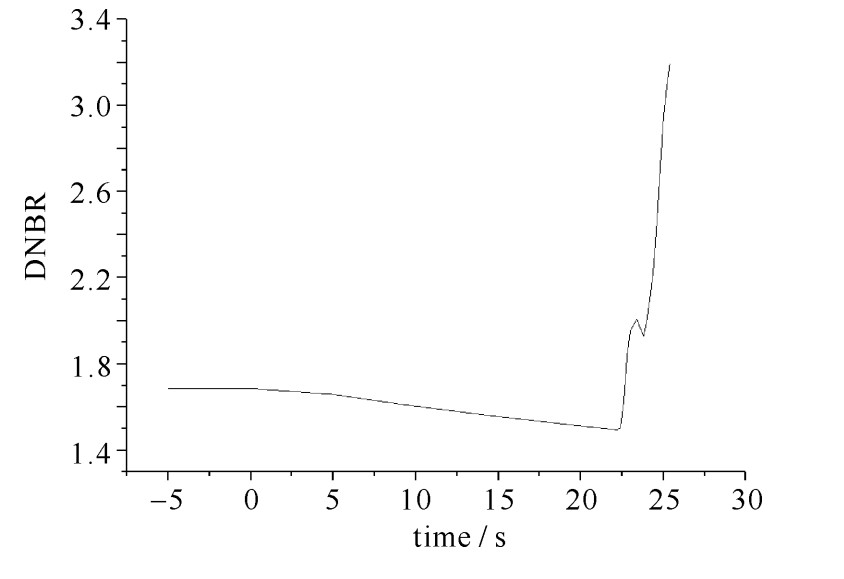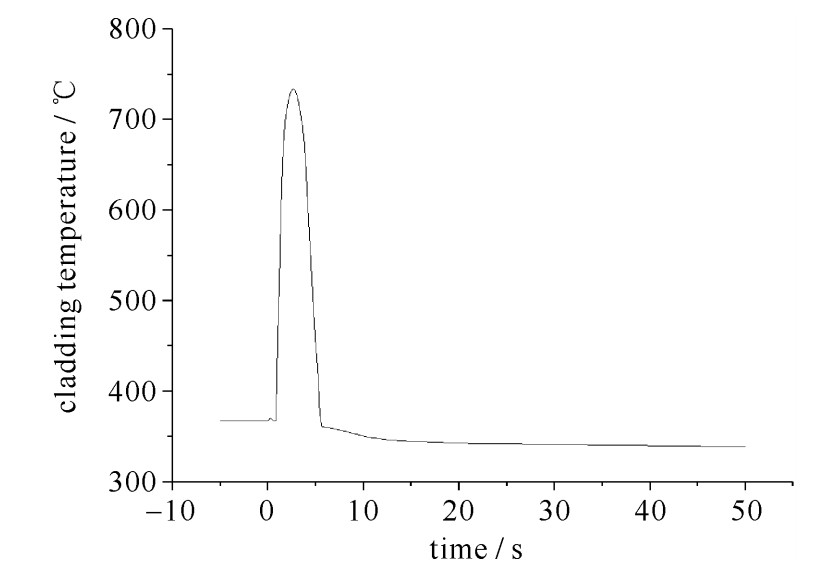Simulation of typical accidents in fuel test loop of CMRR
-
摘要: 基于中国绵阳研究堆(CMRR)高温高压辐照考验回路初步设计方案,就回路失水事故(LOCA)及失流事故(LOFA)两类典型事故进行分析。结果表明:回路在冷管段及热管段失水事故下包壳热点温度最高为880.6 ℃及367.6 ℃,均远低于1204 ℃;全部失流事故下最小偏离泡核沸腾比(MDNBR)大于1.5,不会发生偏离泡核沸腾;卡轴事故中包壳最高温度为734.1 ℃,低于1482 ℃。上述结果均满足验收准则,符合安全法规要求。
-
关键词:
- 高温高压辐照考验回路 /
- 失水事故 /
- 失流事故 /
- 中国绵阳研究堆
Abstract: In order to reflect the behavior of the nuclear materials in the operating reactor veritably and roundly, and to supply reliable data for the safety review of the nuclear materials, the most effective solution is building a fuel test loop (FTL) based on the real pressurized water reactor in the research reactor. To ensure the safety of the fuel test loop and the research reactor, it is necessary to analyze the safety of the fuel test loop during accident transient. This article simulates and analyzes two typical kinds of accidents—small break loss-of-coolant accidents (LOCA) and loss-of-flow accidents (LOFA)—based on the origin design of the fuel test loop in China's Mianyang Research Reactor (CMRR). The peak cladding temperature in cold leg SBLOCA and hot leg small break LOCA is 880.6 ℃ and 367.6 ℃ respectively, which is under the critical value (1204 ℃). During the total LOFA, the MDNBR is greater than 1.5, which means there is no departure from nucleate boiling. In the clamp shaft accident, the cladding temperature is 734.1 ℃, which is less than 1482 ℃. The results obtained are consistent with the safety criteria. -
新型核燃料的研发过程中,必须对燃料进行辐照考核。在研究堆内建立模拟真实压水堆运行环境的高温高压辐照考验回路,可以为辐照考核提供广泛、全面、真实、可信的试验环境。目前国内外许多研究堆都配套建设有堆内高温高压试验回路,例如中国高通量工程试验堆(HFETR)的500 kW高温高压回路[1],比利时研究堆(BR2)内的CALLISTO回路[2],韩国HANARO研究堆内的高温高压回路等[3]。辐照考验回路因为其本身的特殊性,须对其进行安全分析。张毅对中国先进研究堆(CARR)内回路进行了失流事故及失水事故的系统分析[4];H.Ahmed针对CALLISTO回路,计算了辐照装置内压力管大破口失水事故瞬态;H.Bae等人对不同破口位置的失水事故进行了分析[5]。回路基于研究堆而建,在安全分析中不仅要考虑回路系统,还应考虑辐照装置与研究堆,但目前将系统分析与辐照装置及研究堆相结合的研究较少。本文介绍基于中国绵阳研究堆(CMRR)的堆内高温高压辐照考验回路初步设计方案,并对回路失水事故(冷/热管段失水事故)和失流事故(全部失流/卡轴事故)两类典型设计基准事故进行计算分析,以验证回路及研究堆在这两种设计基准事故下的安全性。
1. CMRR堆内辐照考验回路设计方案
CMRR堆内高温高压辐照考验回路初步设计方案由中国工程物理研究院完成。在设计过程中,主要考虑了以下几个方面:(1)回路的稳态运行环境应与真实压水堆主回路运行环境保持一致;(2)回路在设计基准事故下的安全性应得到验证,燃料棒不发生熔化;(3)回路不应对研究堆产生较大影响,研究堆冷却水不发生沸腾。
回路设计方案如图 1所示。设计方案包括三条回路。中间回路(二回路)作用是将主回路热量传递至三回路,三回路连接冷却塔,最终将热量通过冷却塔导出。主回路包含堆内辐照装置,放置于CMRR竖直孔道内,内部放有16根待辐照考验的燃料棒。主回路其他主设备还有:稳压器,控制主回路压力;热交换器,将主回路热量传递给中间回路;一台主泵及一台备用泵;电加热器,用以在回路运行前加热回路冷却剂,抬升冷却剂温度平台;安注箱及低压安注系统;化容控制系统。主回路主要设计参数见表 1。
表 1 主回路主要设计参数Table 1. Designed value of key parameters of primary looppower/kW primary loop pressure/MPa argon gap pressure/MPa coolant flow rate/(kg·s-1) inlet coolant temperature/K outlet coolant temperature/K 60 15.5 0.165 3.5 553 583 辐照装置俯视图如图 2所示,其主体由两根同轴压力管组成。双层压力管结构内部间隙填充氩气,填充压强为0.165 MPa。相比于CALLISTO回路内辐照装置填充的氦气[2],氩气具有更低的热导率[6-7],可以充当绝热层,以减小内压力管热应力和对研究堆冷却剂的影响。填充气隙还可以用来监视内压力管的完整性。内压力管破裂会导致气隙压强迅速升高,通过监测间隙压强变化可以判断内压力管完整性。设计时考虑到上述因素,在间隙上方连接有一安全阀,当压力超过1.0 MPa时,自动开启安全阀向水箱泄压以降低间隙压强,从而保证外压力管的完整性,避免辐照装置破损对研究堆造成影响。
辐照装置与主回路的接口均设在装置顶端。冷却剂自主泵流向辐照装置后,从内压力管与围板之间向下流动,在辐照装置底部转向后从围板内向上流经燃料棒表面,最后从顶部流出辐照装置。
2. RELAP5建模
图 3为高温高压回路的RELAP5节点图。节点图包含主回路主要设备,包括辐照装置、稳压器、热交换器、主回路主泵及管道等,电加热系统仅在回路功率运行前开启以抬升冷却剂温度平台,在功率运行及事故过程中无动作,无需对其建模。二回路和三回路不重点考虑。其中辐照装置的建模包含了内压力管和外压力管、氩气间隙、安全阀和竖直孔道内研究堆冷却水。破口用一个触发阀模拟[8],在事故发生0 s时开启。触发阀分别放置在冷管段和热管段,模拟两种不同位置的破口事故。
系统稳态参数见表 2。RELAP5计算值与设计值近乎一致,在事故瞬态计算中是可以接受的。
表 2 系统稳态参数Table 2. Key parameters in steady-statepower/ kW pressure/ MPa inlet coolant temperature/℃ outlet coolant temperature/℃ main loop coolant flow rate/(kg·s-1) argon gap pressure/ MPa cladding temperature/ K design value 600 15.500 280.00 310.00 3.500 0.165 630.00 RELAP5 calculation value 600 15.556 278.89 310.41 3.476 0.175 640.63 辐照装置放置在研究堆孔道内,其裂变功率降低依托研究堆负反应性引入。当回路停堆信号触发后,研究堆停堆信号同时被触发,研究堆停堆系统介入,反应堆达到次临界状态,辐照装置裂变功率也随之降低。
3. 小破口失水事故计算
小破口失水事故瞬态计算基于以下假设:(1)回路在0 s前处于100%功率运行状态,0 s时发生小破口失水事故;(2)触发稳压器低压力信号后0.3 s,停堆信号触发;(3)事故发生后,所有设备失去厂外电,主泵与主给水系统停止运行。
0 s前,回路处于600 kW稳态运行状态,小破口失水事故在0 s时发生。回路破口流量如图 4所示,冷管段失水事故破口流量在瞬间达到峰值4.844 kg/s,而热管段破口流量峰值为3.686 kg/s。这是由两方面原因造成的:一是冷管段破口位置在主泵后,压力较高,与外环境压差更大,导致流量更高;二是热管段冷却剂温度更高,破口处闪蒸现象来得更早,导致流动阻力增加,流量较小[9]。
图 5为稳压器压力变化图。事故发生后稳压器压力迅速降低,触发停堆信号,随后触发中压安注系统,下降趋势变缓,最后低压安注系统介入,主回路压力保持稳定。
整个过程中,热管段事故破口流量几乎均小于冷管段事故破口流量。在热管段事故中,冷却剂要先流经辐照装置才会从破口流出,而冷管段事故中冷却剂反而是从辐照装置流出的。因此,热管段事故辐照装置水位要比冷管段事故水位高,如图 6所示。
图 7是包壳热点温度变化图。冷管段事故中包壳温度在事故发生后迅速升高,约2.8 s时达到峰值880.6 ℃,这是因为破口位置处于冷管段,冷却剂从破口大量流出,流动方向与稳态运行时相反,在辐照装置内会发生流量反转现象,导致燃料棒产出余热无法被带走,包壳温度升高。热管段事故则没有类似现象,包壳温度在事故发生后迅速降低。这是因为破口发生在热管段,冷却剂流出方向与稳态相同,会增加通过辐照装置内部流量,使得导出热量增加,包壳温度降低。整个过程中包壳温度低于安全限值1204 ℃[10],符合验收准则。
图 8为氩气间隙压力变化图。冷管段事故中压力在事故开始时有小幅度上涨,这是由冷却剂温度上升引起的。热管段事故中则没有这种现象。图 9为CMRR孔道冷却剂温度变化图,两种失水事故下CMRR孔道冷却剂温度都不会发生明显上升。CMRR是池式研究堆,要求冷却剂不发生沸腾,冷却剂温度限值为90 ℃。显然在这两类事故中研究堆冷却剂温度均低于安全限值,可以保证研究堆安全。
4. 失流事故
失流事故是所计算的另一类设计基准事故。本章节计算了两种事故,分别是全部失流事故和卡轴事故。事故发生时,主回路主泵停止运转,回路冷却剂失去驱动力。两种事故区别在于,卡轴事故中主泵没有发生惰转,而失流事故中有主泵惰转。计算结果验证了回路在失流事故中的安全性。
图 10是在事故初期50 s内通过辐照装置的冷却剂流量图。全部失流事故中主泵发生堕转,冷却剂流量下降速度较为缓慢,在21.8 s时降低为2.85 kg/s,触发低流量停堆信号,功率迅速下降。卡轴事故中流量在事故发生后迅速下降,极短时间内触发了低流量停堆信号,回路功率下降,如图 11所示。
图 12为稳压器压力变化图。全部失流事故发生后回路冷却能力降低,冷却剂出口温度上升,稳压器压力上涨。稳压器压力在22.6 s时达到峰值15.624 MPa,随后由于功率迅速降低,稳压器压力回落。反观卡轴事故,由于通过辐照装置流量下降迅速,导致回路短时间内几乎丧失冷却能力,因此辐照装置出口冷却剂温度增高明显,稳压器压力上升幅度大。可以看到稳压器压力在事故开始后大幅上升,在6.4 s达到峰值压力16.21 MPa。随后由于功率降低,稳压器压力回落。整个过程中压力峰值均低于110%设计压力。
全部失流事故被归为II类工况,而卡轴事故则被归为IV类工况,二者验收准则有所不同[10]。图 13为全部失流事故中DNBR变化图,整个过程中MDNBR大于1.5,出现在事故发生后22.0 s,意味着没有发生偏离泡核沸腾,且回路压力低于110%设计压力,符合验收准则[10]。图 14为卡轴事故包壳热点温度变化图。在事故发生后2.4 s,包壳温度达到峰值,约为734.1 ℃,随后由于功率下降及回路自然循环带走余热,包壳温度回落。整个过程中包壳热点温度小于温升极限1482 ℃[10],且回路压力低于120%设计值,满足验收准则。
5. 结论
本文基于CMRR堆内高温高压辐照考验回路初步设计方案,建立了RELAP5模型,模型稳态运行关键参数与设计值保持一致。在此基础上进行了冷/热管段失水事故及卡轴/失流事故瞬态计算。结果表明,冷/热管段失水事故中包壳热点温度最高分别为880.6 ℃及367.6 ℃,低于限值1204 ℃;CMRR孔道内冷却水温变化幅度很小;双层压力管间隙压力在冷管段事故中涨幅很小,不会对双层压力管结构产生冲击;全部失流事故中MDNBR大于1.5,燃料元件表面不会发生偏离泡核沸腾;卡轴事故中包壳热点温度最高为734.1 ℃,低于1482 ℃,回路压力低于120%设计压力。计算结果表明,回路设计方案能应对所计算事故瞬态,回路与CMRR的安全都能得到保障。
致谢: 感谢中国工程物理研究院核物理与化学研究所202科室郭斯茂老师及王冠博老师给予的指导和帮助。 -
表 1 主回路主要设计参数
Table 1. Designed value of key parameters of primary loop
power/kW primary loop pressure/MPa argon gap pressure/MPa coolant flow rate/(kg·s-1) inlet coolant temperature/K outlet coolant temperature/K 60 15.5 0.165 3.5 553 583 表 2 系统稳态参数
Table 2. Key parameters in steady-state
power/ kW pressure/ MPa inlet coolant temperature/℃ outlet coolant temperature/℃ main loop coolant flow rate/(kg·s-1) argon gap pressure/ MPa cladding temperature/ K design value 600 15.500 280.00 310.00 3.500 0.165 630.00 RELAP5 calculation value 600 15.556 278.89 310.41 3.476 0.175 640.63 -
[1] 程作用, 张劲松, 李忠宪, 等. 500 kW考验回路水中F-和Cl-的低压离子色谱分析[J]. 核动力工程, 1996, 17(5): 477-480. https://www.cnki.com.cn/Article/CJFDTOTAL-HDLG605.016.htmCheng Zuoyong, Zhang Jingsong, Li Zhongxian, et al. Analysis of F- and Cl- ions in the primary circuit water of 500 kW test loop by low pressure ion chromatography. Nuclear Power Engineering, 1996, 17(5): 477-480 https://www.cnki.com.cn/Article/CJFDTOTAL-HDLG605.016.htm [2] Hadjam A, Souidi F, Loubar A, et al. Simulation of a LBLOCA in the CALLISTO test facility using the best estimate computer code RELAP5/SCDAP3.2[J]. Nuclear Engineering and Design, 2013, 262: 153-167. doi: 10.1016/j.nucengdes.2013.03.052 [3] Choo K N, Cho M S, Kim B G, et al. Material irradiation at Hanaro, Korea[C]//Research Reactor application for Materials under High Neutron Fluence. 2011: 50-51. [4] 张毅. CARR高温高压试验回路事故分析[D]. 北京: 中国原子能科学研究院, 2007: 23-28.Zhang Yi. Accidents analysis of high temperature and high pressure test loop of CARR. Beijing: China Institute of Atomic Energy, 2007: 23-28 [5] Bae H, Kim D E, Yi S J, et al. Comparison of three SBLOCA tests with different break locations using the SMART-ITL facility to estimate the safety of the SMART design[J]. Nuclear Engineering and Technology, 2017, 49(5): 968-978. doi: 10.1016/j.net.2017.04.006 [6] 于平安, 朱瑞安, 喻真烷, 等. 核反应堆热工分析[M]. 西安: 西安交通大学出版社, 1979: 268-269.Yu Ping'an, Zhu Ruian, Yu Zhenwan, et al. Thermal analysis of nuclear reactors. Xi'an: Xi'an Jiaotong University Press, 1979: 268-269 [7] 张学学. 热工基础[M]. 北京: 高等教育出版社, 2006.Zhang Xuexue. Thermal engineering foundation. Beijing: Higher Education Press, 2006 [8] The RELAP5-3D Code Development Team. RELAP5-3D Code Manual Volume1-5[M]. Idaho: INEEL, 2005. [9] 朱继洲, 奚树人, 单建强, 等. 核反应堆安全分析[M]. 西安: 西安交通大学出版社, 2004: 96-102.Zhu Jizhou, Xi Shuren, Shan Jianqiang, et al. Safety analysis of nuclear reactors. Xi'an: Xi'an Jiaotong University Press, 2004: 96-102 [10] 余冀阳, 余尔俊. 核电厂事故分析[M]. 北京: 清华大学出版社, 2012: 23-24.Yu Jiyang, Yu Erjun. Accidents analysis of nuclear plants. Beijing: Tsinghua University Press, 2012: 23-24 期刊类型引用(1)
1. 刘文斌,宋霁阳,邓才玉,康长虎,向玉新,宋雨鸽,刘畅,郭雨非,邢如均. HFETR 2000 kW高温高压考验回路主泵断电事故瞬态特性分析. 核动力工程. 2022(03): 74-77 .  百度学术
百度学术其他类型引用(0)
-






 下载:
下载:













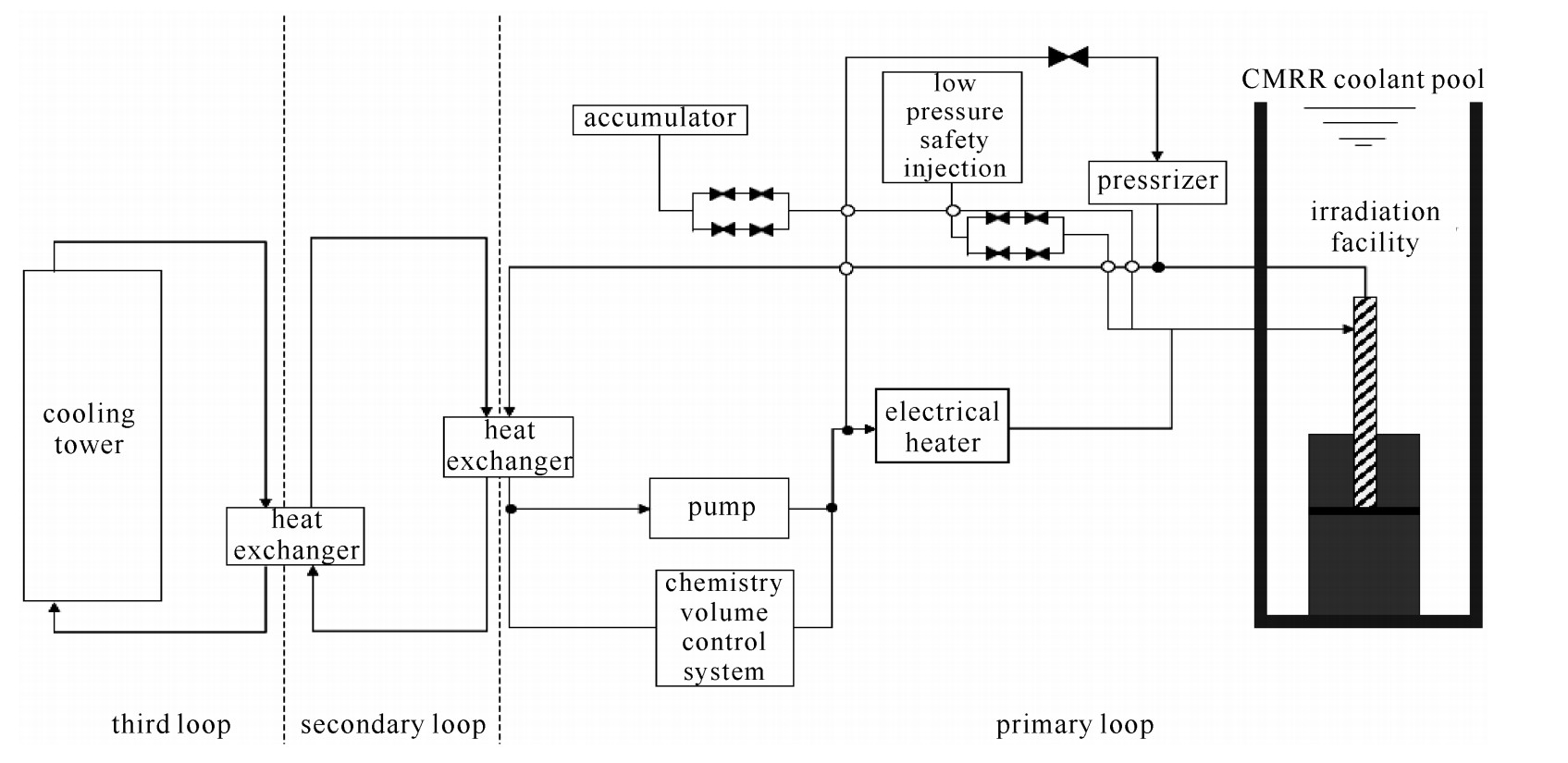
 下载:
下载:
